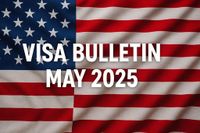The release of the May 2025 visa bulletin by the U.S. Department of State has sent ripples of concern among Indian nationals seeking employment-based green cards, particularly those hoping to benefit from the EB-5 investor visa program. This latest update reveals significant shifts in visa categories, with a notable retrogression in the EB-5 Unreserved category for Indian applicants, creating new hurdles for many families and professionals aiming to secure their futures in the United States.
In a striking development, the EB-5 Unreserved category for Indian nationals has retrogressed by more than six months, with the cutoff date now set at May 1, 2019. This means that only those applicants with priority dates before this threshold can move forward with their applications for adjustment of status. Previously, this category was current, allowing qualified investors to file without delay. Now, those who applied after May 1, 2019, find themselves in a precarious position, facing an uncertain wait as they are temporarily ineligible for adjustment.
For context, the EB-5 visa program allows foreign nationals to obtain U.S. green cards through significant investments in American businesses. The demand for these visas has surged among Indian investors, leading to an early exhaustion of the annual quota of 9,800 EB-5 visas, which is subject to a 7% per-country cap. The U.S. Citizenship and Immigration Services (USCIS) has confirmed that it will only accept adjustment of status applications from those with priority dates earlier than the Final Action Dates listed in the bulletin, reinforcing delays for thousands of hopeful applicants.
While the EB-5 category has dominated headlines, other employment-based categories have also seen movement, albeit minor. For instance, the EB-3 category for Indian applicants has advanced slightly from April 1, 2013, to April 15, 2013. However, the EB-1 category remains unchanged at February 15, 2022, and the EB-2 category continues to stagnate at January 1, 2013. The EB-4 category remains unavailable across all countries due to annual limits being reached, meaning no adjustments are possible until the next fiscal year.
In contrast, the EB-5 Unreserved category remains current for applicants from other countries, including China, which maintains its cutoff date at January 22, 2014. This disparity highlights the intense competition and high demand among Indian applicants, which often triggers retrogressions more frequently than for other nations.
In addition to employment-based categories, family-sponsored preferences also play a crucial role in the immigration landscape. Fortunately, the final action dates for family-sponsored categories for Indian applicants remain stable. However, there has been a significant advancement in filing dates for F2A (Spouses and Children of Permanent Residents), which have moved forward from October 15, 2024, to February 1, 2025. This change allows thousands of families to file their documents earlier, expediting their path to permanent residence.
Understanding the intricacies of the visa bulletin is vital for applicants. The Final Action Dates indicate when green cards can actually be issued, while Dates for Filing allow applicants to submit their paperwork but do not guarantee approval if the Final Action Date hasn’t been reached. Therefore, it is crucial for applicants to monitor these updates closely and maintain valid immigration status in the meantime.
The retrogression in the EB-5 category is particularly impactful, as it stalls progress for many who invested in U.S. projects after May 2019. The backlog created by this retrogression could take years to resolve, leaving many in a state of uncertainty. As a result, experts recommend that individuals maintain lawful status, explore temporary visa extensions, and consult with immigration attorneys to discuss alternative pathways, such as EB-1C for managers.
As the immigration landscape continues to evolve, the May 2025 visa bulletin serves as a reminder of the challenges faced by many Indian nationals in their quest for employment-based green cards. The high demand for EB-5 visas, coupled with the per-country cap, has created significant bottlenecks, and the recent retrogression underscores the need for strategic planning and patience among applicants.
Moreover, the USCIS has emphasized that it will honor the Final Action Dates for the May 2025 adjustment of status filings. This clarification is essential for applicants as they navigate their immigration journeys. Filing prematurely, under the assumption that the Date for Filing chart is applicable, can lead to delays or denials, further complicating the already intricate process.
As the U.S. immigration system grapples with high demand and limited availability, Indian nationals seeking green cards are urged to stay informed and proactive. Keeping an eye on quarterly updates and maintaining valid immigration status will be key to navigating the complexities of the system. The May 2025 visa bulletin may have brought disappointing news, but it also highlights the importance of resilience and adaptability in the face of ongoing challenges.
In summary, while the May 2025 visa bulletin presents a mixed bag of news for Indian applicants, the slight advancements in the EB-3 category and the significant movement in family-sponsored preferences offer some hope. However, the retrogression in the EB-5 Unreserved category is a stark reminder of the hurdles that lie ahead for many. As the immigration landscape continues to shift, the journey to securing a green card remains fraught with challenges, requiring careful navigation and strategic planning.


